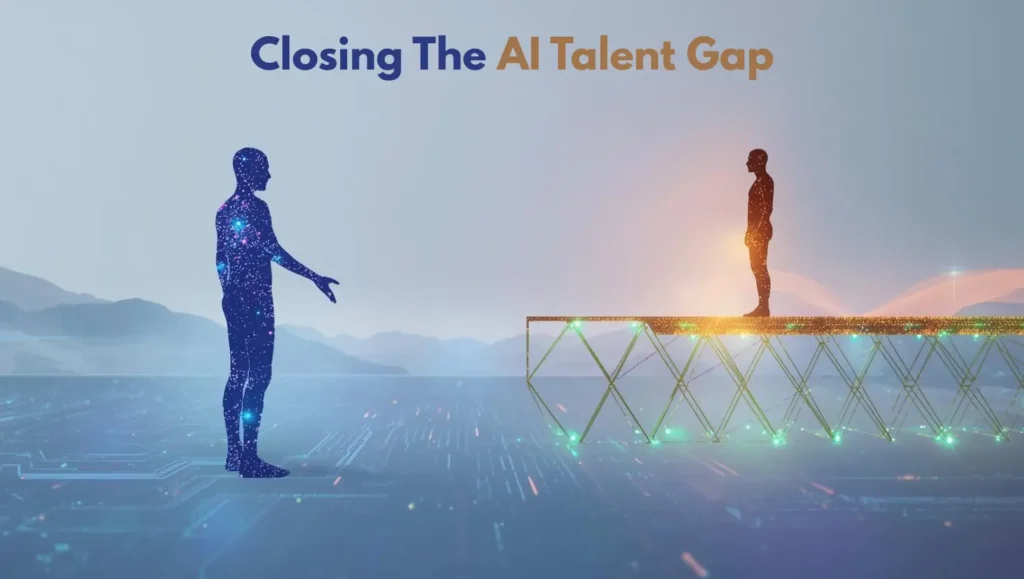In 2026, Artificial Intelligence (AI) and data analytics are no longer just industry buzzwords; they are the core engines of business innovation, efficiency, and growth. As companies rush to harness the power of AI, they’re all hitting the same wall: finding the right people.
The reality is that the demand for skilled AI engineers, data scientists, and machine learning (ML) experts far outstrips the supply. This has created a critical talent gap that makes specialized staffing solutions essential. Without the right expertise, even the most ambitious AI strategies will remain on the drawing board, leaving businesses vulnerable in a rapidly evolving digital world.
The Unrelenting Demand for AI and Data Talent
Today’s businesses aren’t just looking for general IT staff. They need specialists who can build, scale, and interpret complex AI systems. The most in-demand roles include:
AI Engineers
The architects who build and deploy intelligent applications.
Data Scientists
The storytellers who turn raw data into actionable business insights.
Machine Learning Experts
The visionaries who create the predictive models that power automation and forecasting.
What’s Fueling This Hiring Frenzy?
Several major trends are pushing the need for AI talent into overdrive:
- The explosion of generative AI applications in every sector.
- The widespread adoption of automation to streamline business operations.
- An urgent need for real-time analytics to make sense of big data.
- The rise of AI-powered personalization to create better customer experiences.
These trends highlight a clear need for agile and reliable AI staffing partners who can adapt to a company’s shifting priorities.
The Real-World Challenges in Finding Data and Analytics Talent
Fierce Competition for a Limited Talent Pool
It’s a candidate’s market. Top AI professionals are being aggressively recruited by tech giants and well-funded startups, often leaving other enterprises struggling to even get a foot in the door.
Skills Are Evolving Faster Than Training
AI technology moves at lightning speed. The skills that are critical today might be outdated tomorrow. This makes it incredibly difficult for internal training programs to keep up, creating a constant need for fresh expertise.
Balancing High Costs with Clear ROI
The salaries and recruitment fees for top AI talent are astronomical.8 This puts immense pressure on businesses to prove the return on investment (ROI) for every hire. Flexible staffing models are crucial to manage costs without sacrificing quality.
Innovative Staffing Solutions for the 2026 Workplace
Onshore, Nearshore, and Offshore: A Global Approach
To find talent, smart companies are looking globally:
Onshore
Local talent for seamless collaboration and integration.
Nearshore
Cost-effective experts in similar time zones to maintain agility.
Offshore
Access to a deep, scalable talent pool at a significant cost advantage.
Fractional Talent: Top-Tier Expertise on Demand
Not every project needs a full-time, permanent hire. The fractional model allows companies to bring in elite AI and data science professionals on a part-time or project basis.10 Think of it as having a world-class expert on speed dial, without the full-time salary.
AI Implementation Support: From Hire to Impact
Simply hiring an expert isn’t enough. AI implementation staffing ensures that new talent has the support to integrate their projects into existing systems, navigate company workflows, and deliver real value.
Building a Future-Proof Workforce Strategy
Leveraging Machine Learning Staffing and Consulting
Since machine learning is at the heart of most enterprise AI, partnering with specialized ML staffing and consulting firms provides access to niche expertise for critical projects without the long-term overhead.
Aligning Staffing with Your Digital Transformation Goals
Your talent strategy can’t exist in a silo. It must be woven directly into your company’s broader digital transformation roadmap. This ensures every hire contributes directly to revenue growth, operational efficiency, and a stronger competitive edge.
AI Readiness and Governance: Preparing for a Sustainable Future
Navigating Compliance and Data Governance
With new AI regulations emerging globally, it’s vital to ensure every project is compliant and ethically sound. AI readiness and governance services help businesses build a framework for responsible AI use, protecting them from legal and reputational risks.
Upskilling and Reskilling Your Internal Teams
You can’t hire your way out of the talent gap forever. The most sustainable strategy involves investing in your current workforce. By upskilling and reskilling internal staff, you can create powerful hybrid teams that combine deep institutional knowledge with cutting-edge external expertise.
Case Studies: Lessons from the Field
Success Story
A Fortune 500 bank was struggling to accelerate its AI product development. By partnering with an offshore AI staffing firm, they gained access to a dedicated team of ML experts, cutting their hiring costs by 40% and launching their new platform six months ahead of schedule.
Lessons Learned
On the flip side, we’ve seen promising AI projects crumble. A retail company invested millions in hiring a data science team but failed to provide proper implementation support. The team worked in isolation, their models were never integrated, and the investment yielded zero ROI.
The Outlook Beyond 2026: The Evolving Workforce
The future isn’t about humans versus machines; it’s about human-AI collaboration. The most successful organizations will be those that build hybrid workforces. As AI technology continues to advance, a flexible and adaptive talent strategy, blending fractional experts, global teams, and full-time hires, will be the key to staying ahead of the curve.
Frequently Asked Questions (FAQs)
Why is it so hard to find great AI talent in 2026?
The demand for AI skills is growing much faster than the number of qualified professionals, thanks to rapid technological advances and widespread business adoption.
What is the difference between onshore, nearshore, and offshore staffing?
Onshore refers to hiring talent locally. Nearshore means hiring from nearby countries with similar time zones. Offshore involves sourcing talent from more distant global markets, often for cost and scalability benefits.
How can fractional AI talent benefit my company?
It provides access to top-tier, specialized skills on a flexible, part-time basis. This is a cost-effective way to get expert guidance without the commitment of a full-time hire.
Why are AI readiness and governance services important?
They ensure your AI projects are compliant with regulations, ethically sound, and smoothly integrated into your business, minimizing risk and maximizing impact.
Should we focus on hiring externally or reskilling our current employees?
The best approach is a hybrid one. Combining external hiring for specialized, immediate needs with internal reskilling creates a robust and sustainable talent pipeline for the long term.
Which industries benefit the most from these staffing services?
Finance, healthcare, retail, and manufacturing are leading the pack, as they are industries swimming in data and can see a massive and immediate impact from AI and analytics.
Conclusion: It’s Time to Bridge the Analytics Staffing Gap
The AI talent shortage is one of the single biggest obstacles to business innovation in 2026. However, it’s a challenge that can be overcome with a modern, flexible approach to staffing. By embracing solutions like fractional talent, global staffing models, and strategic AI readiness, your company can build the workforce it needs to thrive. The enterprises that will dominate the next decade won’t just be the ones with the best technology; they will be the ones that master the art of building and empowering human talent.


